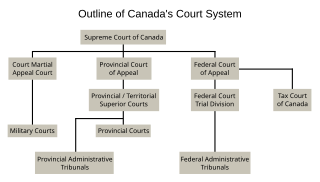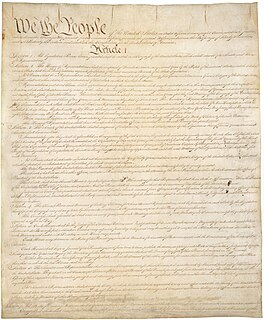Contempt of court, often referred to simply as "contempt", is the offense of being disobedient to or disrespectful toward a court of law and its officers in the form of behavior that opposes or defies the authority, justice and dignity of the court. A very similar attitude towards a legislative body is termed contempt of Parliament or contempt of Congress.
In common law legal systems, precedent is a principle or rule established in a previous legal case that is either binding on or persuasive for a court or other tribunal when deciding subsequent cases with similar issues or facts. Common-law legal systems place great value on deciding cases according to consistent principled rules, so that similar facts will yield similar and predictable outcomes, and observance of precedent is the mechanism by which that goal is attained. The principle by which judges are bound to precedents is known as stare decisis. Common-law precedent is a third kind of law, on equal footing with statutory law and delegated legislation or regulatory law.
Case law is a set of past rulings by tribunals that meet their respective jurisdictions' rules to be cited as precedent. These interpretations are distinguished from statutory law, which are the statutes and codes enacted by legislative bodies, and regulatory law, which are regulations established by executive agencies based on statutes. The term "case law" is applied to any set of previous rulings by an adjudicatory tribunal that guides future rulings; for example, patent office case law.

The Fifth and Fourteenth Amendments to the United States Constitution each contain a due process clause. Due process deals with the administration of justice and thus the due process clause acts as a safeguard from arbitrary denial of life, liberty, or property by the government outside the sanction of law. The Supreme Court of the United States interprets the clauses more broadly, concluding that these clauses provide four protections: procedural due process, substantive due process, a prohibition against vague laws, and as the vehicle for the incorporation of the Bill of Rights.
In administrative law, rule-making is the process that executive and independent agencies use to create, or promulgate, regulations. In general, legislatures first set broad policy mandates by passing statutes, then agencies create more detailed regulations through rulemaking.

The court system of Canada forms the judicial branch of government, formally known as "the Queen on the Bench", which interprets the law and is made up of many courts differing in levels of legal superiority and separated by jurisdiction. Some of the courts are federal in nature, while others are provincial or territorial.

Article IV, Section 1 of the United States Constitution, the Full Faith and Credit Clause, addresses the duties that states within the United States have to respect the "public acts, records, and judicial proceedings of every other state." According to the Supreme Court, there is a difference between the credit owed to laws as compared to the credit owed to judgments. Judgments are generally entitled to greater respect than laws, in other states. At present, it is widely agreed that this Clause of the Constitution has little impact on a court's choice of law decision, although this Clause of the Constitution was once interpreted differently.
Strauder v. West Virginia, 100 U.S. 303 (1880), was a United States Supreme Court case about racial discrimination and United States constitutional criminal procedure. Strauder was the first instance where the Supreme Court reversed a state court decision denying a defendant's motion to remove his criminal trial to federal court pursuant to Section 3 of the Civil Rights Act of 1866.
Statutory interpretation is the process by which courts interpret and apply legislation. Some amount of interpretation is often necessary when a case involves a statute. Sometimes the words of a statute have a plain and straightforward meaning. But in many cases, there is some ambiguity or vagueness in the words of the statute that must be resolved by the judge. To find the meanings of statutes, judges use various tools and methods of statutory interpretation, including traditional canons of statutory interpretation, legislative history, and purpose.
In common law jurisdictions, the judiciary may apply rules of statutory interpretation both to legislation enacted by the legislature and to delegated legislation such as administrative agency regulations.

Federal tribunals in the United States are those tribunals established by the federal government of the United States for the purpose of deciding the constitutionality of federal laws and for resolving other disputes about federal laws. They include both Article III tribunals as well as adjudicative entities which are classified as Article I or Article IV tribunals. Some of the latter entities are also formally denominated as courts, but they do not enjoy certain protections afforded to Article III courts. These tribunals are described in reference to the article of the United States Constitution from which the tribunal's authority stems. The use of the term "tribunal" in this context as a blanket term to encompass both courts and other adjudicative entities comes from section 8 of Article I of the Constitution, which expressly grants Congress the power to constitute tribunals inferior to the U.S. Supreme Court.
In law, the standard of review is the amount of deference given by one court in reviewing a decision of a lower court or tribunal. A low standard of review means that the decision under review will be varied or overturned if the reviewing court considers there is any error at all in the lower court's decision. A high standard of review means that deference is accorded to the decision under review, so that it will not be disturbed just because the reviewing court might have decided the matter differently; it will be varied only if the higher court considers the decision to have obvious error. The standard of review may be set by statute or precedent. In the United States, "standard of review" also has a separate meaning concerning the level of deference the judiciary gives to Congress when ruling on the constitutionality of legislation.
Sherbert v. Verner, 374 U.S. 398 (1963), was a case in which the Supreme Court of the United States held that the Free Exercise Clause of the First Amendment required the government to demonstrate both a compelling interest and that the law in question was narrowly tailored before it denied unemployment compensation to someone who was fired because her job requirements substantially conflicted with her religion.
Canadian administrative law is the body of law that addresses the actions and operations of governments and governmental agencies in Canada. That is, the law concerns the manner in which courts can review the decisions of administrative decision-makers (ADMs) such as a board, tribunal, commission, agency or minister.
Cunningham v. California, 549 U.S. 270 (2007), held that the rule first announced in Apprendi v. New Jersey, 530 U.S. 466 (2000), applies to California's Determinate Sentencing Law. In California, a judge may choose one of three sentences for a crime—a low, middle, or high term. There must exist specific aggravating factors about the crime before a judge may impose the high term. Under the Apprendi rule, as explained in Blakely v. Washington, 542 U.S. 296 (2004), any fact that increases the punishment above that which the judge may impose without that fact must be found by a jury beyond a reasonable doubt. In People v. Black, the California Supreme Court rejected the argument that under Blakely, the jury must find the additional facts necessary for the judge to impose the high term under the DSL. In Cunningham, the U.S. Supreme Court overruled Black, ruling that Blakely applies to California's determinate sentencing scheme.

The Fifth Amendment to the United States Constitution addresses criminal procedure and other aspects of the Constitution. It was ratified in 1791 as part of the Bill of Rights. The Fifth Amendment applies to every level of the government, including the federal, state, and local levels, as well as any corporation, private enterprise, group, or individual, or any foreign government in regards to a US citizen or resident of the US. The Supreme Court furthered the protections of this amendment through the Due Process Clause of the Fourteenth Amendment.
The Double Jeopardy Clause of the Fifth Amendment to the United States Constitution provides: "[N]or shall any person be subject for the same offence to be twice put in jeopardy of life or limb..." The four essential protections included are prohibitions against, for the same offense:
The copyright law of the United States is intended to encourage the creation of art and culture by rewarding authors and artists with a set of exclusive rights. Copyright law grants authors and artists the exclusive right to make and sell copies of their works, the right to create derivative works, and the right to perform or display their works publicly. These exclusive rights are subject to a time limit, and generally expire 70 years after the author's death. In the United States, any music composed before January 1, 1923, is generally considered public domain.

The law of the United States comprises many levels of codified and uncodified forms of law, of which the most important is the United States Constitution, the foundation of the federal government of the United States. The Constitution sets out the boundaries of federal law, which consists of Acts of Congress, treaties ratified by the Senate, regulations promulgated by the executive branch, and case law originating from the federal judiciary. The United States Code is the official compilation and codification of general and permanent federal statutory law.
Washington v. Texas, 388 U.S. 14 (1967), is a United States Supreme Court case in which the Court decided that the Compulsory Process Clause of the Sixth Amendment to the Constitution is applicable in state courts as well as federal courts. Jackie Washington had attempted to call his co-defendant as a witness, but was blocked by Texas courts because state law prevented co-defendants from testifying for each other, under the theory that they would be likely to lie for each other on the stand.
Matal v. Tam, 582 U.S. ___ (2017), is a United States Supreme Court case in which the Court affirmed unanimously the judgment of the Court of Appeals for the Federal Circuit that the provisions of the Lanham Act's prohibiting the registration of trademarks that may "disparage" persons, institutions, beliefs, or national symbols with the United States Patent and Trademark Office violated the First Amendment.





